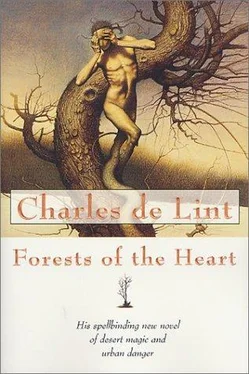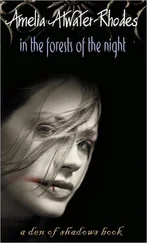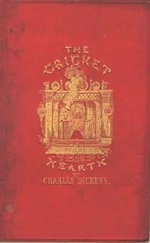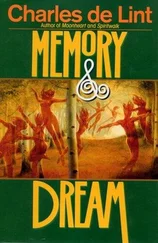She was somewhere in her mid-forties, a tall, handsome woman with striking green eyes and a flame of red hair only vaguely tamed into a loose bun at the back of her head. While her wardrobe consisted entirely of men’s clothes—pleated trousers and dress shirts, tweed vests and casual sports jackets—there was nothing mannish about her figure or her demeanor. Yet neither was she as passive as she might seem. True, her step was light, her voice soft and low. She might listen more than she spoke, and rarely initiate a conversation as she had this evening, but there was still that undercurrent of brujería that lay like smoldering coals behind her eyes. La brujería, and an impression that while the world might not always fully engage her, something in it certainly amused her.
Bettina had been trying to make sense of the housekeeper ever since they’d met, but she was no more successful now, nine months on, than she’d been the first day Nuala opened the front door and welcomed her into Kellygnow, the old house at the top of the hill that was now her home. Kellygnow she learned after she moved in, meant “the nut wood” in some Gaelic language—though no one seemed quite sure which one. But there were certainly nut trees on the hill. Oak, hazel, chestnut.
There were many things Bettina hadn’t been expecting about this place Adelita had found for her to stay. The mystery of Nuala was only one of them. Kellygnow was much bigger than she’d been prepared for, an enormous rambling structure with dozens of bedrooms, studios, and odd little room-sized nooks, as well as a half-dozen cottages in the woods out back. The property was larger, too—especially for this part of the city—taking up almost forty acres of prime real estate. With the neighboring properties ranging in the mil lion-dollar-and-up range, Bettina couldn’t imagine what the house and its grounds were worth. Its neighbors were all owned by stockbrokers and investors, bankers and the CEOs of multinational corporations, celebrities and the nouveau riche—a far cry from the bohemian types Bettina shared her lodgings with.
For Kellygnow was a writers’ and artists’ colony, founded in the early 1990s by Sarah Hanson, a descendant of the original owner. She had been a respected artist and essayist in her time, a rarity at the turn of the century, but was now better remembered for the haven she had created for her fellow artists and writers.
The colony was the oldest property in the area, standing alone at the top of Handfast Road with a view that would do the Newford Tourist Board’s pamphlets proud. There was a tower, four stories high in the northwest corner of the house. From the upper windows of one side you could look down on the city: Ferryside, the river, Foxville, Crowsea, downtown, the canal, the East Side. At night, the various neighborhoods blended into an Indio traders’ market, the lights spread out like the sparkling trinkets on a hundred blankets. From another window you could see, first the estates that made up the Beaches; below them, rows of tasteful condos blending into the hillside; beyond them, the lakefront properties; and then finally the lake itself, shimmering in the starlight, ice rimming the shore in thick, playful displays of abstract whimsy. Far in the distance the ice thinned out, ending in open water.
The view behind the house was blocked by trees. Hazels and chestnuts. Tamaracks and cedar, birch and pine. Most impressive were the huge towering oaks that, she learned later, were thought to be part of the original growth forest that had once laid claim to all the land in an unbroken sweep from the Kickaha Mountains down to the shores of the lake. These few giants had been spared the axes of homesteaders and lumbermen alike by the property’s original owner, Virgil Hanson, whose home had been one of the cottages that still stood out back. It was, Bettina had been told, the oldest building in Newford, a small stone croft topping the wooded hill long before the first Dutch settlers had begun to build along the shores of the river below.
Adelita had never lived in Kellygnow, but before moving back home to Tubac and opening her gallery, she had studied fine art at Butler University and some of her crowd had been residents. It would be the prefect place for Bettina, she said. Let her handle it. She would make a few calls. Everything would be arranged.
“I’m not an artist or a writer,” Bettina had said.
“No, but you’re an excellent model and in that house, one good model would be more welcome than a dozen of the world’s best artists. Créeme. Trust me. Only don’t tell Mama or she’ll have both our heads.”
No, Bettina had thought. Mama would definitely not approve. Mama was already upset enough that Bettina was moving. If she were to know that her youngest daughter expected to make her living by being paid to sit for artists, often in the nude, she would be horrified.
Bettina had thought to only stay in the house for as long as it took her to find an apartment in the city. She was given one of the nooks to make her own—a small space under a staircase that opened up into a hidden room twice the size of her bedroom at home. There was a recessed window looking out on the backyard, overhung with ivy on the outside and with just room enough for her to sit on its sill if she pulled her knees up to her chin. There was also a single brass bed with shiny, knobbed posts and a cedar chest at its foot that lent the room a resonant scent. A small pine armoire. A worn, black leather reading chair with a tall glass-shaded lamp beside it, both “borrowed” from the library at some point, she was sure, since they matched its furnishings. And wonder of wonders, a piece of John Early’s work: a gray, fired-clay sculpture of the Virgin wearing a quizzical smile, blue-robed and decorated with a halo of porcupine quills cunningly worked into the clay and painted gold. In front of the statue, that first day, she found a half-burned candle—someone had been using the statue as the centerpiece for their own small chapel of the Immaculata, she’d thought at first. Or perhaps they had simply enjoyed candlelight as much as she did.
Either way, she felt welcomed and blessed.
The one week turned into a month. Adelita had been right. The artists were delighted to have her in residence, constantly vying for her time in their studios. They were good company, as were the writers who only emerged from their quarters at odd times for meals or a sudden need to hear a human voice. And if their intentions were sometimes less than honorable—women as well as men—they were quick to respect her wishes and put the incident behind them.
The one month stretched into three, four. She needed no money for either rent or board, and had barely touched the savings she’d brought with her. Most mornings she sat for one or another of the artists, sometimes for a group of them. Her afternoons and evenings were usually her own. At first she explored the city, but when the weather turned colder, she cocooned in the house, reading, listening to music in one or another of the communal living rooms, often spending time in the company of the gardener Salvador and helping him prepare the property for winter.
And she began to trade her fetishes and channs. First to some of those living in the house, then to customers the residents introduced her to. As her abuela had taught her, she set no fee, asked for no recompense, but they all gave her something anyway. Mostly money, but sometimes books they thought she would like, or small pieces of original art—sketches, drawings, color studies—which she preferred the most. Her walls were now decorated with her growing hoard of art while a stack of books rose thigh-high from the floor beside her chair.
The few months grew into a half year, and now the house felt like a home. She was no closer to discovering what had drawn her to this city, what it was that whispered in her bones from the hills to the north, but it didn’t seem as immediate a concern as it had when she’d first stepped off the plane, her small suitcase in one hand, her knapsack on her back with its herbs, tinctures, and the raw materials with which she made her fetishes. The need to know was no longer so important. Or perhaps she was growing more patient—a concept that would have greatly amused her abuela. She could wait for the mystery to come to her.
Читать дальше












